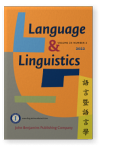Vol. 23:2 (2022) ► pp.147–190
Emotion terms in Malay
Patterns in [meN-], [meN‑ -i], [meN‑ -kan], and [‑kan]-only forms
This study examined 25 emotion terms in Malaysian Malay and used corpus data to investigate whether these emotion terms appeared with the [meN-], [meN‑ -i], [meN‑ -kan], and [‑kan]-only forms. The emotion terms were patterned in four different ways. Category One included local emotion verbs that conformed to the pattern [Affector-Affectee]. In this category, the verbs were dominated by the [meN‑ -i] form, with a small number including the suffix [‑kan]-only. A verb in the [meN‑ -kan] form was either a Category Two [Causer meN‑ -kan Causee] pattern or a Category Four [Experiencer meN‑ -kan Event] pattern, among which Category Two had a higher number of instances. Category Three included two possible patterns – [Experiencer meN‑ -i Stimulus] and [Experiencer meN‑ (Stimulus absent)]. We found that the emotion terms with the [meN-]-only form were largely “narrating” the emotions of the speaker or situation, which provided the background, while the emotion terms with the [‑kan]-only form were largely “proposing” the emotion of the speaker or the subject being referred to (cf. Hopper 1983; Bambang Kaswanti Purwo 1988). We were able to discern not only emotion terms in Malay but also their different uses in [meN-], [meN‑ -i], [meN‑ -kan], and [‑kan]-only forms.
Article outline
- 1.Introduction
- 2.[MeN-], [meN‑ -i], [meN‑ -kan], and [‑kan]-only
- 2.1[MeN-]
- 2.2[-i] and [-kan]
- 2.3Semantic roles
- 3.Methodology and results
- 4.Pattern analysis
- 4.1Category One: [Affector-Affectee]
- 4.2Category Two: [Causer-Causee]
- 4.3Category Three: [Experiencer-Stimulus]
- 4.4Category Four: [Experiencer-Event]
- 5.Discussion
- 6.Conclusion and future work
- Acknowledgements
- Notes
- Abbreviations
-
References
For any use beyond this license, please contact the publisher at [email protected].
